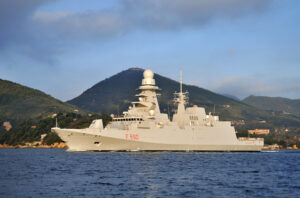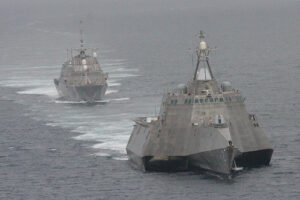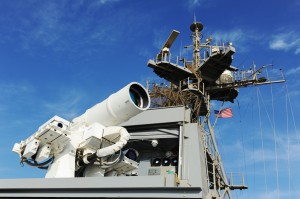Navy Steers Well Away From An LCS Frigate
Posted on

The LCS replaced the Perry-class frigates, like this one, the USS Vandegrift. Now the Navy is looking at more traditional frigate designs once more.
UPDATED w/ Sen. McCain’s “optimism,” Cdr. Clark’s analysis WASHINGTON: At 1:10 pm today, the Navy issued its official wishlist for its future frigate and set a 45-day deadline for shipbuilders to respond. As acting Navy Secretary Sean Stackley had promised, today’s Request For Information (RFI) opens the door wide to both US and foreign designs. It doesn’t lock the Navy into buying an upgraded variant of the current Littoral Combat Ships, but it doesn’t rule that out, either.
Overall, the performance requirements in the RFI suggest a very different vessel than the original LCS, one capable not only of auxiliary duties but of escorting aircraft carriers and supply convoys in conjunction with Aegis destroyers. A few parameters in particular stand out:

The frigate Bergamini, the first Italian variant of Fincantieri’s FREMM class, a potential contender for the US Navy frigate.
- Reliability: The future frigate should be fully functional (“operational availability”) at least 72 percent of the time. Both the single-hulled Freedom and trimaran Independence LCS have suffered embarrassing breakdowns, beyond the normal teething troubles of a new class.
- Survivability: The frigate’s propulsion, weapons, and other “critical systems” should be sufficiently well-protected (“shock hardening”) for the ship to take a hit and keep fighting, at least with its defensive anti-aircraft systems. The original concept for LCS was to retreat for repairs once hit, so critical systems on LCS are not shock-hardened and were tested less rigorously than the Navy norm, according to the Pentagon’s independent Director of Operational Test & Evaluation.
- Crew Size: The frigate may have up to 200 crew. By contrast, reducing crew size — and therefore personnel costs — was a major driver of the original LCS design. The small crew raised concerns about having insufficient manpower for routine maintenance, let alone damage control in battle. Even after increasing the crew, LCS still deploys with about 70 sailors.
- Speed: The frigate must reach and sustain speeds of at least 28 knots (32 mph) . That’s fast enough to keep up with a carrier battle group, but it’s slow compared to the LCS, which can sprint at over 40 knots. That top speed required enormous, expensive, and complex engines relative to the size of the ship, as well as exotically streamlined hulls, driving the whole design, but the Navy never found a solid tactical reason for going that fast.
In short, the Navy wants the frigate to do certain things better than the LCS — and the things the LCS does well, the Navy doesn’t care much about.

LCS-2, USS Independence, followed by LCS-1, USS Freedom, showing the two different designs.
Then there’s the loaded question of weapons. The Navy had already committed to installing a long-range Over The Horizon (OTH) anti-ship missile on both the future frigates and, through retrofits, to the existing LCS. It had ruled out the major modifications to the ship required to install Vertical Launch Systems — essentially, missile silos built into the hull — although both LCS manufacturers said they could add VLS to their designs if asked. The new Request For Information asks for a minimum of eight OTH missiles, but then it raises an intriguing possibility of heavier armament that would require a VLS.
- First, the RFI says “the Navy is particularly interested” in defensive weapons, specifically naming the Evolved Sea Sparrow Missile (ESSM) and the SM-2 Standard Missile. While the ESSM can be launched from rails mounted on deck, the SM-2 is almost always fired from a Vertical Launch System. (The Navy briefly used rail launchers for SM-2s, but they were all retired in favor of VLS).
- Then, the Navy indicates further interest in “strike length variants to maximize weapons flexibility” — i.e. launch systems capable of handling offensive weapons as well as defensive ones — “if able to be cost effectively integrated.” While very cautious and cost-constrained, this language suggests a strong interest in the dual-purpose offensive/defensive Vertical Launch System.
Another intriguing detail is the instruction that all designs must reserve 26 tons of weight and 600 kilowatts of electrical power “for future Directed Energy and Active EA.” EA means electronic attack, i.e. jamming enemy radios and radars, a vital military specialty in which the US has lost ground compared to Russia and China. “Directed energy” means high-powered microwaves and lasers. The Navy has been keenly interested in defensive lasers, putting one on the USS Ponce in the Persian Gulf to shoot down drones — but that’s only a 30-kilowatt weapon: the future frigate could fire a far more powerful laser.

The Navy’s Laser Weapons System (LaWS) aboard the USS Ponce in the Persian Gulf
It’s important to remember that the Navy is still exploring the art of the possible here, and is not yet building a ship. The Request For Information (RFI) is just that, asking companies to provide their existing ship designs, estimated costs to modify them to Navy requirements, and rough costs and schedules to build the first ship in 2020 and two more a year thereafter.
This is not the official beginning of a competition — that would be the Request For Proposals, RFP — nor a binding commitment on the Navy’s part. But with those caveats, the Request For Information gives a fascinating window into what the Navy wants.

John McCain
UPDATED LCS arch-critic John McCain, chairman of the Senate Armed Services Committee, announced Wednesday that he was “cautiously optimistic” about the Navy’s direction. “I am cautiously optimistic regarding the request for information on a new Frigate program that the Navy released yesterday,” McCain said in a statement. “This new Frigate must be more capable than the Littoral Combat Ship (LCS) program, with minor modifications. For example, the new Frigate’s ability to perform local area air defense for convoys of ships would provide a necessary and clear capability improvement over the LCS program.”
Meanwhile, retired Navy Commander Bryan Clark, a former top aide to the Chief of Naval Operations, gave us his analysis of the requirements — putting particular emphasis on places where the Navy seems willing to accept less powerful, more affordable frigate:
“The RFI implies the Navy is still concerned about the cost of the new ship and perhaps wants to use the FFG(X) as something other than a traditional frigate,” Clark wrote in an email. “This RFI incorporates several optional requirements that would reduce the FFG(X)’s capability and cost. For example:

Bryan Clark
“The FFG(X) is not required to do air defense for another ship. (It) would conduct ASW (anti-submarine warfare) and ASUW (anti-surface warfare) and have improved survivability against air threats. The RFI leaves open the degree to which the FFG(X) would be able to do air defense for another ship, asking respondents to propose how they would provide for air defense, and what launchers, such as VLS, they would use to host ESSM and SM-2 interceptors. ESSM would provide the bare minimum capability needed to defend another ship, but only in very constrained geometries where the FFG(X) is very close to the defended ship and between the defended ship and an incoming missile. In other situations, an SM-2 would probably be required.”
The Navy is leaving its options open here, Clark said, because it’s leery of installing heavy-duty air defense would increase cost and degrade performance, potentially to the point it knocks LCS-derived designs out of the running. “While Congress is pushing foreign designs such as the Fincantieri FREMM or Navantia F-105 (which already have VLS installed), the Navy likely wants variants of the current LCS to be able to compete for FFG(X),” he said. “To include VLS, the Freedom-class LCS would likely need a hull extension; the Austal LCS may be heavier with VLS and become slower and less efficient.”
Similarly, Clark notes, the RFI only requires passive, defensive electronic warfare systems, not active jamming capability, and it puts anti-submarine warfare at a lower priority (“Tier 2”) than either defensive systems or offensive anti-ship weapons. “While the RFI says the Navy wants a ship capable of doing (both) ASUW and ASW,” he said, “this could result in an option for FFG(X) that is less expensive and focused on ASUW.”
Overall, Clark said, these requirements suggest less a traditional frigate than a kind of picket ship, a spotter transmitting targeting data to more powerful vessels: “Instead of being a full-up multi-mission frigate, the RFI suggests the FFG(X)’s job is to support Distributed Maritime Operations and Distributed Lethality by hosting unmanned systems and acting as a remote active and passive sensor to support shooters over the horizon” — such as the more powerful Aegis destroyers.
Subscribe to our newsletter
Promotions, new products and sales. Directly to your inbox.
